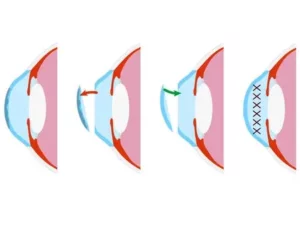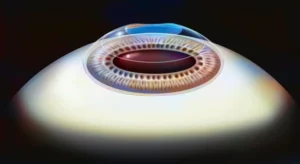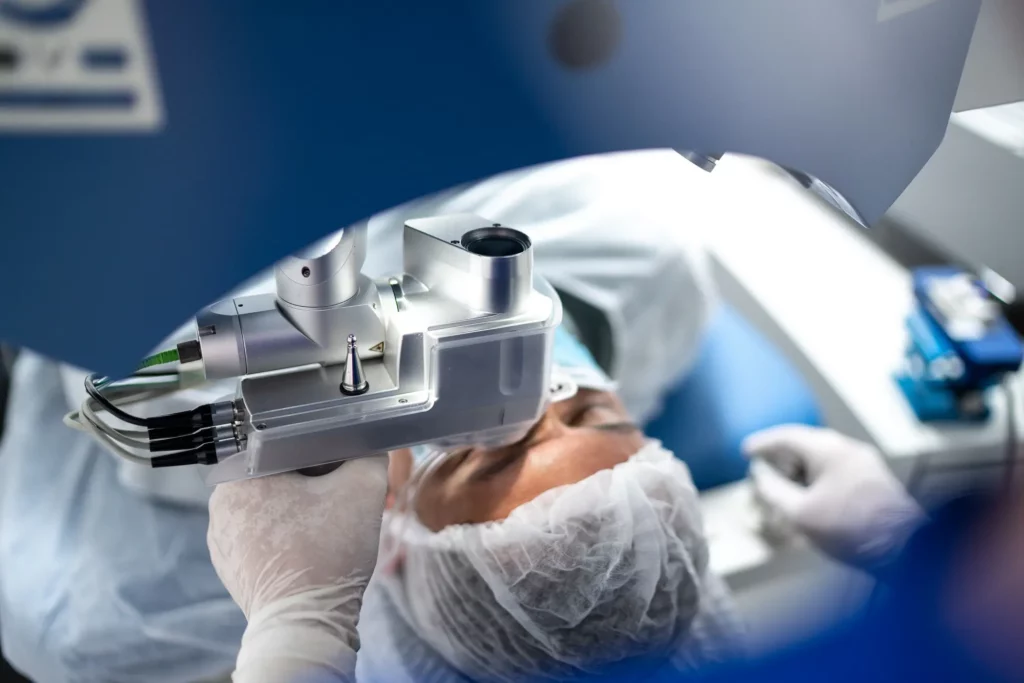Are you tired of reaching for your glasses every morning or struggling with the hassle of contact lenses? Imagine a world where your vision is crystal clear, unencumbered by the limitations of corrective eyewear. In this article, we will provide a comprehensive overview of Excimer Laser PRK (Photorefractive Keratectomy), a popular vision correction procedure. So let’s get started!
Contents
What Is Excimer Laser and What Is It Used For?
 The excimer laser is a specialized type of laser that emits ultraviolet light with a unique wavelength. It is widely used in various medical and surgical procedures. Let’s delve into what the excimer laser is and how it is utilized in these procedures.
The excimer laser is a specialized type of laser that emits ultraviolet light with a unique wavelength. It is widely used in various medical and surgical procedures. Let’s delve into what the excimer laser is and how it is utilized in these procedures.
The excimer laser derives its name from the excimer molecules it generates. An excimer is a short-lived, excited dimeric or heterodimeric molecule that forms when a noble gas and a halogen are combined in a specific energy state. In the case of the excimer laser, the noble gas used is usually argon or xenon, while the halogen is typically fluorine or chlorine.
What makes the excimer laser unique is its ability to deliver pulses of ultraviolet light at a precise wavelength of around 193 nanometers. This specific wavelength allows the laser to interact with tissue in a highly controlled manner, enabling surgeons to perform intricate procedures with exceptional precision.
Does PRK Use Excimer Laser?
One of the key components of the PRK (Photorefractive Keratectomy) procedure is the excimer laser. This advanced technology plays a crucial role in reshaping the cornea to correct vision problems. Let’s explore how PRK utilizes the excimer laser and why it is an integral part of the procedure.
How Does Excimer Laser PRK Work?
 Let’s delve into the step-by-step process of how Excimer Laser PRK works.
Let’s delve into the step-by-step process of how Excimer Laser PRK works.
- Preparation and Anesthesia: Before the procedure begins, the patient’s eye is numbed using anesthetic eye drops. This ensures a comfortable experience throughout the surgery.
- Epithelial Removal: The first step of Excimer Laser PRK involves gently removing the outer layer of the cornea, known as the epithelium. This can be done using a specialized instrument or by utilizing the laser itself. By removing the epithelium, the surgeon gains access to the underlying corneal tissue that will undergo reshaping.
- Reshaping with the Excimer Laser: Once the cornea is prepared, the surgeon uses the excimer laser to reshape the underlying corneal tissue. The laser is precisely programmed with the patient’s specific vision prescription, which guides the amount and pattern of tissue removal. The excimer laser emits pulses of ultraviolet light at a specific wavelength, ablating microscopic amounts of tissue with incredible accuracy and without generating heat. The laser reshapes the cornea by precisely sculpting its curvature, correcting the refractive errors that were present.
- Post-Reshaping Evaluation: After the corneal reshaping is complete, the surgeon evaluates the cornea to ensure the desired corrections have been achieved. This may involve various tests, including checking the corneal topography and measuring the refractive error.
- Bandage Contact Lens Placement: Following the reshaping, a temporary bandage contact lens is placed on the eye to protect the cornea and promote healing. This contact lens acts as a protective barrier while the epithelium regenerates, which typically takes several days to a week.
Post-Surgery Expectations
 After undergoing Excimer Laser PRK (Photorefractive Keratectomy), it’s important to have realistic post-surgery expectations. Here are key points to consider:
After undergoing Excimer Laser PRK (Photorefractive Keratectomy), it’s important to have realistic post-surgery expectations. Here are key points to consider:
- Initial recovery: Expect discomfort, light sensitivity, and blurry vision during the first phase of recovery. The eye may feel scratchy or irritated. These symptoms are temporary and will improve as the eye heals.
- Vision fluctuations: Anticipate blurry or hazy vision initially, with improvements over time as the cornea heals and stabilizes. Full visual outcome may take weeks or months. Be patient and allow the eye to adjust.
- Healing and stabilization: Healing time varies, so some may heal quicker than others. Follow post-operative care instructions to ensure optimal healing. The cornea will undergo subtle changes during healing, leading to clearer vision gradually.
- Visual improvement: Excimer Laser PRK aims to improve visual acuity and reduce reliance on glasses or contacts. Results vary, with some achieving 20/20 vision or better. Mild prescription eyewear may still be needed for specific activities.
- Long-term stability: Once the cornea stabilizes, visual improvements are generally permanent. However, age-related changes like presbyopia may occur. Regular eye examinations are recommended to monitor any changes.
- Follow-up care: Attending post-surgery appointments is crucial. The surgeon will monitor healing, measure visual acuity, and address concerns. Promptly communicate any unexpected symptoms or issues.
Is Excimer Laser Safe for Eyes?
Yes, the Excimer Laser used in procedures like PRK (Photorefractive Keratectomy) is considered safe for the eyes when performed by qualified and experienced surgeons. Here are important points to understand about the safety of the Excimer Laser:
- FDA Approval and Testing: The Excimer Laser technology has undergone rigorous testing and received FDA approval, ensuring adherence to safety and efficacy standards.
- Precise and Controlled: The laser emits ultraviolet light at a specific wavelength, precisely removing microscopic amounts of tissue without generating heat.
- Tissue Selectivity: The laser selectively targets the cornea, minimizing the risk of damage to surrounding eye structures.
- Experienced Surgeons: Qualified ophthalmic surgeons who specialize in refractive surgeries operate the Excimer Laser with expertise and experience.
- Pre-operative Evaluation: Patients undergo comprehensive eye examinations to assess suitability for the procedure and identify any potential risks or contraindications.
What Are The Risks Of Excimer Laser?
 Here are the key risks associated with Excimer Laser treatment:
Here are the key risks associated with Excimer Laser treatment:
- Dry Eyes: Excimer Laser procedures can temporarily disrupt the normal tear film, leading to dryness and discomfort. Lubricating eye drops and other measures can help manage this condition during the healing process.
- Infection: While rare, there is a small risk of developing an eye infection after Excimer Laser treatment. Adhering to proper post-operative hygiene and using prescribed eye drops can minimize this risk.
- Glare and Halos: Some patients may experience glare or halos around lights, especially at night. These visual disturbances are usually temporary and diminish as the eyes heal. However, in rare cases, they can persist.
- Under-correction or Over-correction: While the Excimer Laser is highly precise, achieving the exact desired correction may not always be possible. In some cases, the refractive error may be under-corrected or over-corrected, requiring further enhancement or additional vision correction methods.
- Regression: Over time, a small percentage of patients may experience a partial reversal of the achieved vision correction. This is known as regression. Regular follow-up appointments with the surgeon help monitor any changes and address potential regression if necessary.
- Corneal Haze: In certain cases, a temporary clouding of the cornea, known as corneal haze, may occur during the healing process. This typically resolves on its own, but in rare instances, it may require additional treatment.
Conclusion
In conclusion, Excimer Laser PRK (Photorefractive Keratectomy) is a safe and effective vision correction procedure that utilizes advanced technology to reshape the cornea and improve visual acuity. While there are potential risks and complications associated with the procedure, they are relatively rare, and most patients achieve significant improvements in their vision.
By consulting with a qualified and experienced eye surgeon, individuals can determine if Excimer Laser PRK is a suitable option for their vision correction needs and embark on a journey towards improved visual acuity and a higher quality of life.
At EyeMantra, we offer the most advanced lasik options including PRK, Femto Lasik, SMILE surgery, Standard lasik, ICL and Contoura vision. So if you have any questions on Lasik surgery in Delhi, Lasik surgery cost and Lasik procedure, call us at 9711116605 or email at [email protected].


